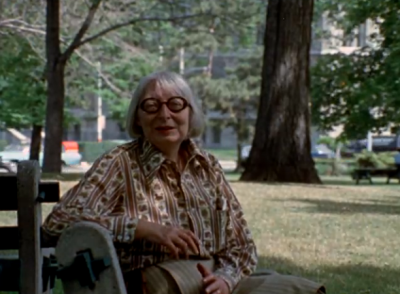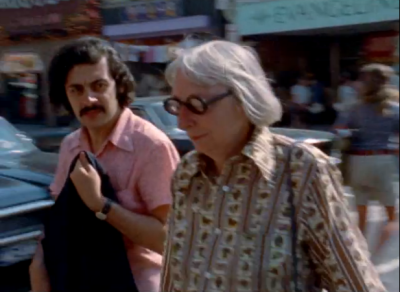
City Limits is a lovely 1971 film about Jane Jacobs. You can watch the whole thing here; it’s about 30 mins long. Directed by Laurence Hyde for the Canadian National Film Board, the documentary features Jacobs talking through her ideas, interspersed with some terrific footage of Toronto, New York, London and other cities around the world. I’m indebted to Martin Dittus for digging it out of the NFB archives.

The 30-minute film is worth watching for many reasons. For starters, Jacobs herself appears in much of it – sat in a park, shopping in a market, buying a newspaper, and at one point clambering into a helicopter to survey Toronto from above.

*
At the same time, the film is a great summary of Jacobs’ big ideas about how urban neighbourhoods – and cities – work, when they succeed and when they fail. Jacobs is a superb writer, but she never spells it out for you. The film does, and in the author’s own words:
A city is an organism, and a very complex one, and an ever changing one. I would like us to see cities as ecologies – because that’s what they are. As surely as the ecologies of the natural world. The ecology of a city is of the same order of complexity as the ecology of a woodland. And this is what proper city planning ought to be directed to.
This is the essence of a crucial chapter buried in the back of The Death and Life of Great American Cities: ‘The Kind of Problem a City Is’ (page 558 in my edition). It’s the research design for the book: it’s also Jacobs’ whole way of doing urbanism.




*
Watching the film reminds me how prescient Jacobs was. There’s a surprising sequence on cultural diversity, which Jacobs presents both as an amenity, and as a channel of innovation:
Foreign districts introduce extra dimensions into a city. They often introduce new kinds of food, new customs, new music, even new kinds of clothing. And they’re a lot of fun for people who aren’t familiar with those customs, foods and so on. … that’s the way things spread in cities. And from cities to other places.

This innovation argument is the big idea from The Economy of Cities. ‘Jacobian externalities’ are knowledge spillovers across sectors: these are self-reinforcing, and help cities become resilient to economic shocks. What I hadn’t previously spotted was that Jacobs sees *cultural* and *economic* diversity as so closely intertwined.

Jacobs also makes some subtle points about mobility and technology. She came to prominence in New York opposing Robert Moses’ megaschemes for urban motorways and ‘sum clearance’: not surprisingly, then, much of the film is concerned with congestion and pollution. But Jacobs has a much more profound argument:
People worry that there’s too much progress – in fact it’s just the opposite. … Automobiles don’t represent progress any more – they’re pretty old …
There’s no solution in saying people should live close to their work and shouldn’t travel. People change their jobs, goods have to move. So the problem is mobility – but the automobile isn’t providing much of an answer.
In other words: the car-based city is old thinking. The future is mass transit, bikes, and mobility as a service, enabled by technology. Scroll forward to 2016, and that future is taking shape all around us.
In 1971, however, this meant ‘Dial-a-Bus’ [link7] – a prehistoric Uber Pool, summoned to your house by landline and whisking you and fellow commuters to the local train station.

*
Jacobs was a thinker and an activist, not a consultant. It’s not as easy as it looks to derive practical guidance from her work – not least because she is the original full-field urbanist, drawing together history, built form, economics, social structure and culture into her analysis. Watching the film is a salutary reminder of this; it also emphasises how much Jacobs’ work draws on close observation of specific places she knows well.
Death and Life … tends to be distilled into four urban design tropes: high density, short city blocks, mixed use, old buildings. Result: every 1990s block of flats with space for a shop at the bottom (but VAT rules that incentivise developers to knock down old buildings). That’s clearly not enough to make a street or neighbourhood ‘work’, if it has no relation to the demographics and socio-economic life around it. The film is a neat reminder that we shouldn’t reduce Jacobs to design code box-ticking. But it also highlights just how tricky it is to roll her ideas into generalised practice. ‘What should a city be like?’ asked Reason in 2001. Jacobs’ answer: ‘it should be like itself’.
*

The film also highlights how much Jacobs’ thinking about urbanism is a product of its time. All around her cities were losing people to the suburbs, and losing old urban grain to modernist, car-centric city form. Many neighbourhoods were emptying out. In London and New York today, all of that has flipped around: populations are growing, high-value activity is back, and we have an urgent crisis of housing and cheap space.
Ed Glaeser famously has a go at Jacobs in The Triumph of the City, arguing that preserving old buildings simply chokes off the supply of bigger, newer ones, and the subsequent gentrification pushes out the artists and mixed communities she sought to preserve. I’m not sure that’s completely fair: she was dealing with a different era’s problems. But it also seems that she had fairly little to say about today’s urban crises. That is the message from of this 2003 Brick interview, conducted three years before Jacobs’ death. She’s asked whether today’s cities are in better shape. She replies:
In some ways there’re worse and in some ways better. The things that are worse I don’t think are so much focused or anchored in cities as they are in our North American culture as a whole … I think that things are getting better for cities in that there’s not the great ruthless wiping away of their most interesting areas that took place in the past … however, I think the urban sprawl outside of cities has gotten much worse.
In the Reason interview she goes a little further, citing Portland, Seattle and San Francisco as ‘attractive places … where good things are being done.’ The interviewer asks about gentrification and rising prices. She bats away the question.
By this point her writing had also moved on to other issues: the nature of work, economic ecosystems. Clearly, she wasn’t much interested in going back to the street.
*
It’s early morning, and the city is beginning to dance. The camera follows Jacobs as she crosses a busy street. A man walking beside her notices the camera and gazes in increasing curiousity at our heroine, trying to place her. Unable to do so, he wanders away. Lost in thought, she disappears into the crowd.




*
Here’s the link to the film again.
























